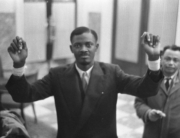With its knotty screenplay and enigmatic performances, Aaron Schimberg’s A Different Man is one of the more unpredictable and surprising films of the year so far.
Set in contemporary New York City, it has a thoroughly rich feel for downtown apartment living (a surly neighbor, a leak in the ceiling, a sudden banging on the door). Sebastian Stan plays Edward, a man with neurofibromatosis, who is also a struggling actor. Nervous and feeling the daily stress of constant stares and looks from others, he has difficulty communicating with those around him. His neighbor and aspiring playwright Ingrid (Renate Reinsve of The Worst Person in the World) seems genuinely curious and sympathetic toward Edward, but he tends to lock himself in his apartment, longingly watching the hallway as a guy visits her apartment to hookup.
When Edward takes part in a medical trial to cure his condition, the results come across as almost fantastical, with a heightened Frankenstein feel. The film has pleasurable twists and turns, and it’s not too much of a giveaway that the treatment is successful. (The make-up effects are stunningly done.) From then on, Edward, with his handsome face, takes on a new identity as a real estate agent. However, his existence is up-ended again when he crosses paths with Oswald (Adam Pearson), a man who has neurofibromatosis, but who lives his life with joie de vivre, much to Edward’s chagrin and existential discomfort.
Schimberg’s script is a winding ride, peppered with black comedy and ambiguity. It deals with Edward’s neurofibromatosis in an empathetic manner, without becoming treacly or didactic. Pearson’s supporting performance adds a jolt of energy when he enters the picture midway. His Oswald, a perfect foil to Edward, is everything that Oswald is not: confident, apparently limitless in different hobbies and skills, independently wealthy, and capable of amassing rapt attention and adoration from a karaoke audience.
Some may remember Pearson from Jonathan Glazer’s Under the Skin. His magnetic turn here will hopefully attract more attention. Reinsve, so layered and impressive in Worst Person, is a reserved yet beguiling presence. I was sometimes distracted by her wigs, but Schimberg’s direction is knowingly stagey at times for a movie about donning different identities and roles. Stan, perhaps best known for his Marvel filmography, is very unsettling. He portrays Edward as never quite comfortable with himself, both before and afterward his treatment. Fortunately, he avoids hamming it up under his prosthetics, but creates a plausible character instead. His richest work comes in the second half. While he dons a conventionally attractive appearance, he’s addled and tormented inside.
Rome-based composer Umberto Smerilli’s lavish and mysterious score, with a jazzy, memorable theme, infuses the film with atmosphere and mood. The main theme is so persistent that it creates a sense of overriding tension as Edward undergoes so many personal and physical changes. It’s very much a movie score—darkly comic—and a departure from recent indies with more minimalist music, while adding a patina of artifice to the picture that’s perhaps for the best. A more straightforward, realistic approach may have come off as pedantic. Shot on Kodak, Wyatt Garfield’s grainy, dark-hued cinematography particularly excels in the apartment scenes, encapsulating the uneasiness of the setting and characters. Even if the tonal shifts and plot jumps don’t always land effectively, this bruised, intriguing story lingers.







Leave A Comment